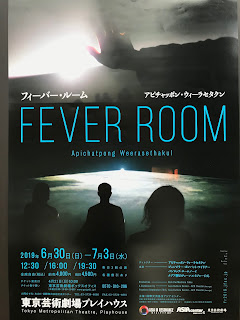Fever Room By Apichatpong Weerasethakul at Tokyo Metropolitan Theatre, July 3rd 2019
In the era of streaming and while everyone anticipates the disappearance of the movie theater, Apichatpong Weerasethakul is a filmmaker that continues to be fascinated with the notion of film as a collective experience. What this idea embodies is the overall concept of Fever Room, an installation that has toured countries in Europe and Asia wowing audiences in its path. If you have a chance to experience it please don’t hesitate, it’s a truly unique experience. If that’s the case I’d ask you to stop reading, because in this post there will be information that could potentially spoil the experience.
After being guided through a somewhat dark maze along with rest of the audience, we found our spots near the front, sitting on cushions on the floor. Just a few minutes later the place went to pitch black darkness and a screen descended from the ceiling. The projection started with a series of images shown twice described each time by an unseen character using a single word for each image. The series is identical both times, establishing the importance of point of view, as in the same event seeing with different eyes, like an audience does in a cinema.
The place becomes slightly more clear with the light coming from a second screen that descends about twenty minutes into the projection, positioning itself on top of the first one. The two screens depict a scene of people riding a boat and later descending from it. Usually split screens mean seeing the same event from two different points of view. In this case, even though it appears to be the same action -a group of people descending from a boat- and it involves the same group of actors and extras, you can tell that it’s not a single event shot with two cameras. Defeating the purpose of a split screen, showing differences rather than a microscopic privileged view of an event, reflects the multiple perspectives stemming from an audience instead of from what’s depicted on screen. In other words, the movie theater experience is in the essence of the concept, much more than the movie itself.
From the sides two other screen descend and now the place is bathed with light. The images on the screens show waves crashing on the shore. That brightness contrast with the dark imagery that follows. A rainy alley at night and then a man exploring a cave. For some reason I thought about Kubrick’s 2001: A space Odyssey, perhaps the quintessential “best experienced in theaters” movie. In Fever Room the man at the cave in his unexplained search reminded me of Bowman disconnecting HAL. Also because what followed was a full incarnation of the stargate sequence.
Be warned that I’m about to describe one of the most impactful reveals I’ve ever experienced, so please stop reading if you haven’t seen Fever Room. What happened was that the screens went back up and the curtain behind the main one in front was lifted. I was expecting a set where actors will continue with this hybrid installation, but no, we see the empty seats of the theater, we were on stage all this time! We are the movie!
Just like those primitive murals in caves drawn thousands of years ago, everything was reduced to its essence at this point. A single source of light projected on the audience. Smoke and sounds evoking a storm. This sort of conduit or gateway that connects reality with the dreamscape of movies is emphasized by the primal role of light as the essence of imagery. Smoke will be invisible until a beam of light hits it, then it becomes apparent. Same could be said about images in a movie screen. The concept is brilliant, but it’s the realization of it, in the midst of this installation that it’s unlike anything else. Pardon the hyperbole, but it was truly a unique experience.
From the prehistoric cave setting, the piece closes with an image that resembles a painting from the renaissance. After the curtain comes back obscuring the place and one of the screens from the side descends, a slow iris -just like the ones used in movies at the beginning of the 20th century- slowly reveals the man in the cave lying on top of rocks. This time his bright nude torso contrasts with the darkness of his environment bringing a closure to the dichotomies between light and darkness, dreams and reality, movie and spectators.
In 2010 I got the chance to interview Apichatpong Weerasethakul when he screened his Palme D’Or winning film Uncle Boonmee Who Can Recall His Past Lives at the Toronto Film Festival. He talked about the mysterious nature of film. He said “we go to the cinema to dream. That operates in a scientific way, but for me it’s a magical way. When we sleep we dream to maybe readjust our brain, our mind. The same way we go to cinema. We enter a certain state of being hypnotized, that’s why I think the theater is very important. Each film is different; it’s magic, a black magic that you don’t know how it works. How through time it shapes the experience, and how sometimes watching a second time changes the experience. The setting, the way you watch the movie, affects also the experience. This medium is a mysterious one for me; I still don’t know how to crack the code, I don’t have the answer of what his nature is”. With each of his works he’s definitely getting closer and closer to cracking the code.
Thank you for reading. Please follow me on Twitter for updates at @ConcertTokyo. You can also click the Like button and get notifications at The Tokyo Concert Experience on Facebook.




Comments
Post a Comment